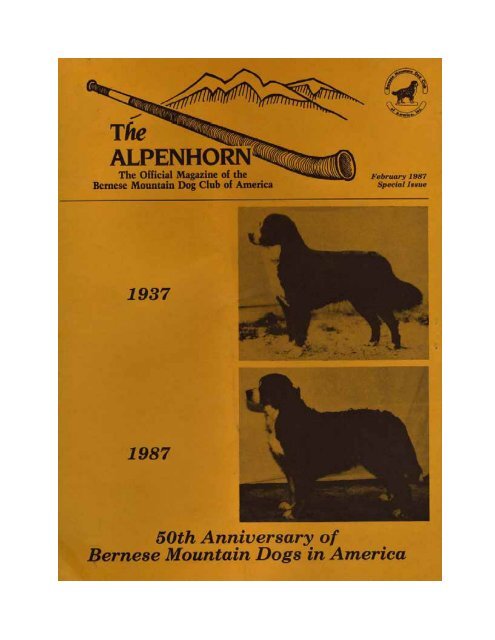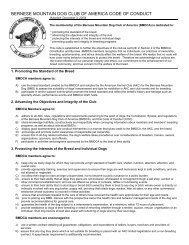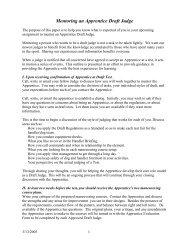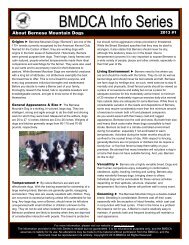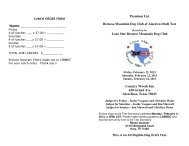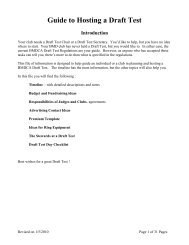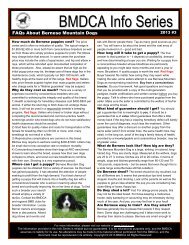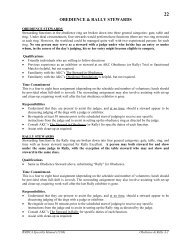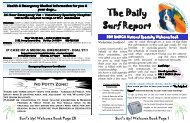Alpenhorn Special, '37-'87 â 50th Anniversary (PDF) - Bernese ...
Alpenhorn Special, '37-'87 â 50th Anniversary (PDF) - Bernese ...
Alpenhorn Special, '37-'87 â 50th Anniversary (PDF) - Bernese ...
Create successful ePaper yourself
Turn your PDF publications into a flip-book with our unique Google optimized e-Paper software.
It seemed to begin so simply. In the May 1, 1937, Issue of the American<br />
Kennel Gazette there was a brief notice: "New Breed Admitted to Stud Book.<br />
<strong>Bernese</strong> Mountain Dog." There followed the newly accepted "Standard of<br />
Perfection" for the breed, which was admitted to the Working Group.<br />
Recognition of the <strong>Bernese</strong> Mountain Dog by the American Kennel Club<br />
actually took place at the meeting of April 13, 1937. There were, we may be<br />
sure, many events, discussions, meetings, and deliberations leading up to<br />
this momentous recognition. The breed had, of course, been recognized and<br />
promoted in its Swiss homeland for many decades prior to this recognition<br />
of Its status by the American Kennel Club. Active promotion of the breed by<br />
Mrs. L. Egg-Leach of England and Switzerland and by the American fancier<br />
Glen Shadow were among these events.<br />
On the occasion of the <strong>50th</strong>, "Golden," <strong>Anniversary</strong> of the recognition of<br />
the <strong>Bernese</strong> Mountain Dog in America, this issue of the newsletter of the<br />
<strong>Bernese</strong> Mountain Dog Club of America is devoted to a retrospective view of<br />
these dogs. Deciphering their history must be based on a number of sources:<br />
archaeological records give us some clues about Swiss dogs; works of art<br />
can be used to document how these farmers' dogs developed; the history of<br />
the breed since its initial promotion by Swiss dog fanciers, starting in<br />
1892, is known from writings of Professor Albert Heim and other early<br />
fanciers. The history of these dogs in America can be told from records of<br />
the American Kennel Club and, since its founding in 1968, from those of the<br />
<strong>Bernese</strong> Mountain Dog Club of America.<br />
Thanks are due to Mary Alice Eschweiler, Chairman of the Records Committee,<br />
for providing valuable information from the Club's archives; to Robert and<br />
Brenda Abrams and Dora Gruber for help with the photographs; to Esther<br />
Mueller for providing background information on the breed; to Deborah<br />
Godfrey and Elizabeth Hill for arranging the computer programs that were<br />
used In this Issue; to Bill and Mary Jo Thomson for critical reading of the<br />
manuscript; and to Roberta Vesley and the Library of the American Kennel<br />
Club for providing information from stud books and registers. Some of the<br />
information here appeared in the first (1968-1972) issue of the Yearbooks<br />
of the <strong>Bernese</strong> Mountain Dog Club of America. The cover features (top) Fridy<br />
v. Haslenbach (A-156,753), first <strong>Bernese</strong> to be registered by the AKC in<br />
1937, and Ch. Taliesin Raclette d'Aldo (WF169978), a representative of the<br />
breed today.<br />
--Mary R. Dawson<br />
Copyright © 1987 by the <strong>Bernese</strong> Mountain Dog Club of America<br />
All rights reserved
Figure 1. A group of modern <strong>Bernese</strong><br />
Mountain Dogs in Switzerland.<br />
Dürsrüti dogs, left to right, Quela,<br />
Wacho, Bunta, Senta, and Bunta v.<br />
Mariland.<br />
PART 1. THE FARM DOGS OF SWITZERLAND<br />
As for many modern purebred dogs, and<br />
especially for those stemming from<br />
association with farming, the early<br />
history of the <strong>Bernese</strong> Mountain Dog<br />
(Berner Sennenhund) is clouded in<br />
obscurity. Until purebreeding started,<br />
which in the case of our breed<br />
occurred around the end of the 19th<br />
century, utility ruled in breeding<br />
dogs. Farmers wanted dogs that were<br />
useful. Apparently our dogs stem from<br />
all purpose farmers' dogs that were<br />
versatile, being capable of serving as<br />
watchdogs around the farmstead as well<br />
as drovers, workers and companions for<br />
the alpine herdsmen (Sennen), and cart<br />
dogs.<br />
Thus, in tracing the prehistory of our<br />
breed we must look to varied sources<br />
that may tell something in general<br />
about the development of dogs in<br />
Switzerland and in particular about<br />
"farmers' dogs."<br />
The area that is now Switzerland has a<br />
long claim to the association between<br />
man and dog. In the archaeological<br />
sites of the Swiss "lake dwellers"<br />
(Pfahlbauern), who inhabited part of<br />
central Switzerland in Neolithic<br />
times, around 2000 to 3000 BC, bones<br />
of small to medium sized dogs are<br />
present. Many of the bones represent<br />
old individuals. Other domestic<br />
animals<br />
of these Neolithic farmers also<br />
tended to be small. Size indicates<br />
that selective breeding for some<br />
characters was being practiced by<br />
these early herdsmen. Later Neolithic<br />
sites contain remains of larger dogs,<br />
as do some from Celtic people in the<br />
Iron Age. Better known is the record<br />
of the Romans, who came north across<br />
the Alps during the first century BC.<br />
The Romans came intending to<br />
provision their troops and to stay,<br />
for they brought with them herds of<br />
cattle and other livestock. It is<br />
very likely that droving dogs were<br />
used in controlling these herds. The<br />
Roman site of Vindonissa, dating from<br />
the first century AD, contains bones<br />
of a dog. According to the Swiss<br />
anatomist Theodore Studer, who<br />
studied the remains around 1901, the<br />
skull is about the size of that of a<br />
<strong>Bernese</strong> farmers' dog. This evidence<br />
has been incorrectly used to show<br />
that <strong>Bernese</strong> Mountain Dogs lived at<br />
the time of the Romans, whereas what<br />
it does show is simply that large<br />
dogs were present in the Roman's<br />
state of Helvetia. Switzerland north<br />
of the Alps was an active crossroads<br />
for movement of tribes and invaders,<br />
and increasing pressures from<br />
Germanic tribes finally led to the<br />
fall of the Romans in Helvetia.<br />
Surely these invading "barbarians"<br />
had dogs for varied purposes and of<br />
varied sizes and appearances, but the<br />
archaeological record is not<br />
extensive.<br />
1
Into and through the Middle Ages the<br />
written record dealing with farmers'<br />
dogs in Switzerland is poor. It is<br />
known that in the 13th century the<br />
nobles in Switzerland prized their<br />
hunting dogs - but allowed no mixing<br />
of these treasured creatures with the<br />
lowly farmers' dogs. Meanwhile,<br />
farmers continued using utility as the<br />
highest requisite for a dog. Some<br />
regional development of different<br />
strains probably occurred in<br />
relatively isolated valleys.<br />
Both Albert Heim, an early promoter of<br />
Swiss farmers' dogs, and later Hans<br />
Räber, editor of Hundesport, the<br />
official publication of the Swiss<br />
Kennel Club, turned to old paintings<br />
in attempts to trace the background of<br />
these dogs. Most paintings were done<br />
of the lap dogs and hunting companions<br />
of the rich and noble, but a few clues<br />
to the background of the Sennenhunde<br />
were found. One painting dating to<br />
1651 by the Dutch painter Paulus<br />
Potter shows a large tricolored dog<br />
that could easily be a <strong>Bernese</strong><br />
Mountain Dog.<br />
Figure 2. Detail from a painting by Potter<br />
(1651) showing a dog resembling the<br />
<strong>Bernese</strong> of today (from Räber, 1984)<br />
Presence of a Swiss farm dog in<br />
Holland could be explained, for herds<br />
of cows, and probably the dogs that<br />
drove the herds, were items of<br />
commerce between the farmers of<br />
Switzerland and the Netherlands.<br />
Later (ca. 1773) paintings by the<br />
Swiss painter Freudenberg show farm<br />
scenes with large tricolored dogs,<br />
again probably related to the Bärris<br />
and Blässis of today.<br />
Up until and through this time<br />
emphasis in dog breeding continued to<br />
be utility. It wasn't until dog<br />
fanciers entered the picture, around<br />
the middle of the 19th century, that<br />
breeding programs were developed that<br />
would preserve the qualities of the<br />
old breeds. Once kennel clubs<br />
started, stud books closed, and<br />
pedigrees remained "pure", breeds as<br />
they are recognized today made their<br />
appearance. For the <strong>Bernese</strong> Mountain<br />
Dog this event in their development<br />
can be traced to Switzerland in the<br />
1890s.<br />
PART 2. THE DÜRRBÄCHLERS<br />
In the latter part of the 19th<br />
century many Swiss dog fanciers began<br />
importing foreign breeds. The only<br />
Swiss breed that was popular was the<br />
Saint Bernard. The local dogs, known<br />
as farmers' dogs, cheese factory<br />
dogs, Gelbbäckler ("Yellow Cheeks"),<br />
or Vieräuger ("Four Eyes", in<br />
reference to the spots over the eyes)<br />
were largely forgotten. But a few<br />
fanciers remembered the old local<br />
dogs and decided to do all they could<br />
to preserve and promote them. Notable<br />
among these was Franz Schertenleib of<br />
Burgdorf near Bern, who in 1892 went<br />
to look for a certain type of dog<br />
that his father had told about. In<br />
the Dürrbach region south of Bern he<br />
found a dog that old timers in<br />
Burgdorf recognized as a Gelbbäckler.<br />
Subsequently Schertenleib returned to<br />
the Dürrbach region and bought more<br />
dogs, and then searched for other<br />
individuals in the remote farm<br />
regions of the Canton of Bern. These<br />
are the dogs that led to the <strong>Bernese</strong><br />
Mountain Dog.<br />
Soon Schertenleib was joined in his<br />
efforts by other fanciers and was<br />
also assisted by Professor Albert<br />
Heim, a noted geologist as well as a<br />
dog fancier. The dogs were called<br />
Dürrbächlers, after their native<br />
area.<br />
2
of Professor Heim, who proposed the<br />
name Berner Sennenhund, noting that<br />
the breed really originated in the<br />
entire Canton of Bern, whereas<br />
Dürrbach was only a small region that<br />
served as a refugium for the dogs<br />
when other breeds were becoming<br />
popular. Thus was born the Berner-<br />
Sennenhund Klub (later the<br />
Schweizerische Klub für Berner<br />
Sennenhunde). A Senn or Senner is an<br />
Alpine herdsman, so the literal<br />
translation of Berner Sennenhund<br />
would be "<strong>Bernese</strong> Alpine Herdsman's<br />
Dog."<br />
Figure 3. Franz Schertenleib, who<br />
searched the Dürrbach area for dogs in<br />
1892 (photo from Herr Iseli).<br />
In 1899 Mr. Probst drew attention to<br />
the Dürrbächlers in the publication<br />
Centralblatt. Later, in 1904, he and a<br />
photographer, Mr. Deppeler, arranged<br />
an experimental class for these dogs<br />
at the International Swiss Kennel Club<br />
show in Bern. Six dogs and one bitch<br />
were entered. Four of these seven were<br />
registered by the Swiss Kennel Club in<br />
1905 (Phylax, no. 2698; Prinz, no.<br />
2699; Ringgi, no. 2700; and Belline,<br />
no. 2701). Eight additional dogs were<br />
registered in 1908. For about ten<br />
years dogs of unknown parentage were<br />
accepted for registration by the Swiss<br />
Kennel Club, following their approval<br />
by one of three experts (Schertenleib,<br />
Mumenthaler, Scheidegger).<br />
Meanwhile, the fanciers formed the<br />
Schweizerischer Dürrbach-Club in 1907,<br />
with headquarters in Burgdorf. Charter<br />
members were: Messrs. Mumenthaler<br />
(president), Schafroth, Gunther,<br />
Heiniger, Schertenleib, Haldimann,<br />
Ritz, Gsteiger, Luthi, Scheidegger,<br />
Bracher. In 1908 the group changed its<br />
name at the suggestion<br />
Figure 4. The hotel at Dürrbach where<br />
early Dürrbächler fanciers gathered<br />
(photo by Erwin Munter, Longstorf).<br />
Both the Club and the breed grew<br />
well. A <strong>Special</strong>ty Show was held in<br />
1910 in Burgdorf, at which all with a<br />
<strong>Bernese</strong> type of dog were invited to<br />
exhibit. One hundred and seven dogs<br />
were shown to judge Professor Heim,<br />
who found that three-quarters of them<br />
were worthy representatives and good<br />
for breeding. Many of these dogs, of<br />
course, were of unknown pedigree, but<br />
they were accepted on the basis of<br />
type. There was still considerable<br />
variation in some features, and,<br />
according to one authority<br />
(Rittmeister v. Stephanitz, Der<br />
deutsche Scahäferhund, January,<br />
1921), some early Berners even had a<br />
red or yellow-red ground color<br />
instead of black.<br />
3
By 1911 the Swiss <strong>Bernese</strong> club had<br />
forty members. As these native dogs<br />
became known in their homeland, their<br />
popularity increased. By 1922 58 were<br />
entered in the Swiss Kennel Club<br />
Registry; this grew to 129 in 1939,<br />
just after the breed was recognized in<br />
America, and 336 in 1948. In that same<br />
year, 1948, although the stud book had<br />
been closed for some time, the<br />
possibility of bringing fresh blood<br />
into the breed was discussed. It is<br />
not clear whether this was done<br />
deliberately or as an accident. The<br />
Berner Sennenhund bitch Christine v.<br />
Lux had seven puppies sired by the<br />
Newfoundland Pluto v. Erlengut. All<br />
the puppies looked like Newfoundlands<br />
with small white markings on the feet.<br />
One female and three males were kept.<br />
The female was mated with the Berner<br />
Sennenhund Aldo v. Tieffurt and had a<br />
litter of eight: one male and one<br />
female resembled Berners but the male<br />
had no white on the hind feet; one<br />
male and one female were Berners but<br />
lacked a blaze; two males were black<br />
with white toes, white spots on the<br />
chin, and a white spot on the chest;<br />
two, stillborn, had irregular blazes.<br />
One of the females, Christine, was<br />
mated with the Berner Osi v.<br />
Allenluften. The five resulting<br />
puppies had all the markings of a<br />
Berner but only two, Alex and Bella,<br />
survived. Of these, the male, Alex v.<br />
Angstorf became very important as a<br />
stud dog and champion. He sired 51<br />
litters, from which no all black dogs<br />
appeared. The experimental cross<br />
breeding was counted as a success, and<br />
indeed Alex v. Angstorf can be found<br />
in the pedigree of many of the dogs of<br />
today.<br />
PART 3. THE NEW AMERICANS<br />
The question of when the first Swiss<br />
farmers' dogs came to America may<br />
never be answered to the satisfaction<br />
of keepers of records. Surely it may<br />
be speculated that Swiss farmers who<br />
emigrated to the New World might have<br />
brought with them their indispensible<br />
dogs for assistance around the farm.<br />
Old photographs in the annals of<br />
American farming give some tantalizing<br />
suggestions about the presence of such<br />
dogs in America. So far as firm<br />
records are concerned, Arthur Hesser,<br />
a noted judge in America and a Swiss<br />
native, provided the following<br />
background (letter to Dora Gruber,<br />
December 6, 1977). "In<br />
4<br />
January 1926, the farmer Isaac<br />
Schiess of Florence, Kansas, bought<br />
the bitch Donna von der Rothöhe SHSB<br />
23314, born 5/27/25, sired by Max<br />
Pulfer 21212 ex Trix von der Rothöhe,<br />
bred by Franz Schertenleib; and the<br />
dog Poincare von Sumiswald SHSB<br />
21565, born July 24, 1924, sired by<br />
Leo Greiner SHSB 9018 ex Netti Iseli,<br />
bred by Fr. Iseli. The importer<br />
wanted to register this pair with the<br />
American Kennel Club, but was not<br />
successful in his attempt, although<br />
Carl Wittwer, the Swiss stud book<br />
registrar (SHSB Stammbuchführer) made<br />
every effort to convince the AKC that<br />
the Berner Sennenhund was a pure bred<br />
Swiss dog. Poincare and Donna<br />
produced a litter of five, born May<br />
29, 1926. Since the AKC had refused<br />
registration for the parents, the<br />
same applied to the litter, and the<br />
breeder Schiess therefore registered<br />
the five with the SKG under the<br />
kennel name "of the Clover Leaf SHSB<br />
25546/25550."<br />
Figure 5. Is this a <strong>Bernese</strong> puppy in this<br />
photo from turn-of-the-century Nebraska?<br />
In the American Kennel Gazette of<br />
June 1, 1935, there appeared an<br />
article by Mrs. L. Egg-Leach, an<br />
English lady living in Switzerland.<br />
"The <strong>Bernese</strong> is a Loyal Dog of the<br />
Swiss Alps" was the enthusiastic<br />
title of the article, in which Mrs.<br />
Egg-Leach extolled the virtues of the<br />
breed and presented attractive<br />
photographs of adults and puppies.<br />
She described her first encounter<br />
with the <strong>Bernese</strong> in Switzerland as<br />
follows: "One day, I saw from afar,<br />
what I thought was a tricolor collie,<br />
harnessed to a small wagon, filled<br />
with milk-cans, taking the milk from<br />
house to house. I had read much about<br />
sled-dogs
and had seen many photographs of them,<br />
but I had never seen a dog in harness<br />
before; above all, one of my lifelong<br />
favorites. It was too much for ne. A<br />
dog was a companion and friend to me,<br />
not something to be used as a beast of<br />
burden.<br />
"I think I lost my head at the<br />
time. I forgot, for the moment that I<br />
was in a strange land, and that<br />
strange lands had strange customs, I<br />
had still much to learn. Not only was<br />
my interest awakened, but my<br />
indignation was aroused at such a<br />
sight. When the dog came nearer, I saw<br />
that it was a totally different breed.<br />
But to me it was a four-footed friend.<br />
I had never read nor heard of this<br />
breed before, and my interest soon<br />
developed into admiration.<br />
"The dog was well cared for, and<br />
his master seemed kind to him.<br />
Certainly the master did not deserve<br />
the bitter reproaches I gave him. I am<br />
thankful to this day that he could not<br />
understand the few words I could-or<br />
thought I could-speak of his language,<br />
for they were not complimentary at<br />
all. I have since learned much about<br />
the draught-dogs, and am fully<br />
convinced that they are happier at<br />
work than when idle."<br />
PART 4. RECOGNITION BY THE AKC<br />
Mrs. Egg-Leach's enthusiastic article<br />
stirred the interest of at least one<br />
reader, one who was to become very<br />
important for the <strong>Bernese</strong> in America.<br />
The reader was Glen L. Shadow of<br />
Ruston, Louisiana. In an article in<br />
the January, 1938, issue of Western<br />
Kennel World Mr. Shadow wrote about<br />
the effect of the article on him and<br />
the results of his interest. His own<br />
words tell it best: "In June, 1935,<br />
while recovering from an attack of<br />
influenza, I read an article published<br />
in the American Kennel Gazette,<br />
written by Mrs. L. Egg-Leach of<br />
Winterthur, Switzerland, about the<br />
<strong>Bernese</strong> Mountain Dogs of the Swiss<br />
Alps. I read this article some two or<br />
three times as this was the dog that I<br />
so much admired from the pictures<br />
showing the dogs drawing the milk<br />
carts in my first grade reader when I<br />
was a child.<br />
"The childish desire to own some of<br />
these dogs was not completely<br />
abandoned, and while I was in France<br />
in 1918 and 1919, I had the<br />
opportunity of seeing some of these<br />
dogs which rekindled this childhood<br />
fancy.<br />
5<br />
Because the financial circumstance<br />
did not permit me to buy or import<br />
these dogs at that time it was<br />
necessary for me to abandon the idea<br />
as there were none to be had in the<br />
United States and no one had thought<br />
enough of this particular breed to<br />
import them.<br />
"After reading Mrs. Egg-Leach's<br />
article, I took the liberty to write<br />
her and ask for further information<br />
regarding them as well as some<br />
assistance in making a purchase.<br />
After some months of correspondence<br />
and untiring efforts on the part of<br />
Mrs. Egg-Leach, she succeeded in<br />
buying for me on August 30, 1936,<br />
Fridy v Haslenbach from Mr. Fritz<br />
Stalder, breeder. This was the best<br />
female dog of her breed in all Europe<br />
and it is useless to say that a very<br />
fancy price was required to purchase<br />
this bitch. Fridy was awarded first<br />
prize in the 1935 dog show at Basle;<br />
also Excellent and C.A.C.I.B., which<br />
is the highest champion certificate<br />
on the continent of Europe, called<br />
the International Beauty Championship<br />
Certificate, and all who have seen<br />
her since her arrival in the United<br />
States agree that it would be<br />
difficult to produce a more perfect<br />
or more beautiful dog.<br />
"On September 28, 1936, I<br />
forwarded draft to Mrs. Egg-Leach to<br />
purchase Quell v Tiergarten (Felix,<br />
kennel name) from Mr. G. Haiti. He<br />
was not the best to be had as the<br />
owner of the best male refused to<br />
sell him at any price."<br />
Mr. Shadow's admiration for these<br />
dogs is clearly shown later in the<br />
article where he wrote, "Anyone<br />
looking into these dogs' deep brown<br />
eyes, can see that they have a<br />
wonderful understanding and a kind,<br />
loving disposition. They are most<br />
affectionate toward children and are<br />
quite courageous in defending their<br />
rights. As a working dog I have never<br />
seen one that I think equals the<br />
<strong>Bernese</strong> Dog and if the homes that<br />
have suffered the loss of children<br />
from vicious kidnappers had had one<br />
of these dogs as a pet and pal for<br />
their child, no one would have been<br />
able to molest them without first<br />
killing the dog."<br />
Clearly the influence of Mr. Shadow<br />
and his enthusiasm for the breed was<br />
vital to the recognition of these<br />
dogs by the American Kennel Club. Mr.<br />
Shadow was
modest about this achievement, writing<br />
simply: "On April 21, 1937, I had a<br />
letter from Mr. Perry B. Rice,<br />
Secretary of the American Kennel Club,<br />
stating that the Board of Directors<br />
held a meeting on Tuesday, April 13,<br />
1937, and it was officially decided to<br />
recognize the <strong>Bernese</strong> Mountain Dog as<br />
a new breed in the Working Class.<br />
These are the first and only dogs of<br />
this breed to ever be registered with<br />
the American Kennel Club or the<br />
Secretary of Agriculture."<br />
The June 1, 1937 issue of American<br />
Kennel Club Registrations carried the<br />
listings of the first two <strong>Bernese</strong><br />
Mountain Dogs ever registered in this<br />
country, Mr. Shadow's Fridy and Felix.<br />
They are:<br />
FRIDY V HASLENBACH (B)(A-156,753)-<br />
Glen L. Shadow. (Br) Frank Stalder,<br />
Switzerland. (Wh) Mar. 9, 1931.<br />
Blk, tn & wh mkgs. By Alex v<br />
Lotzwil out of Cornelia v<br />
Haslenbach by Ajax v Bucheggberg<br />
out of Belline v Binsberg by Nero v<br />
Burrigut out of Badli v Tiergarten;<br />
Ajax v Bucheggberg by Ringgel<br />
(Sonne) out of Miss (Soharrer),<br />
Alex v Lotzwil by Bruno v d<br />
Rotifluh out of Belline v Lotzwil<br />
by Blass v Lehn out of Netti v<br />
Lotzwil; Bruno v d Rotifluh by<br />
Nestor v Bifang out of Belline<br />
(Dennler). QUELL V TIERGARTEN (D)<br />
(A-156,752)-Glen L. Shadow. (Br) A.<br />
Sohoch, Switzerland. (Wh) June 14,<br />
1935. Blk, tn i wh mkgs. By Galant<br />
v Tiergarten out of Sylvia v d<br />
Rothohe by Olaf v d Rothohe out of<br />
Lora v d Rothohe by Bello v d<br />
Rothifluh out of Afra v d Rothohe;<br />
Olaf v d Rothohe by Lord v d<br />
Rothohe out of Belline v d Rothohe.<br />
Galant v Tiergarten by Lord v d<br />
Rothohe out of Carola v d Rothohe<br />
by Max (Pulfer) out of Bella-Sonne;<br />
Lord v d Rothohe by Bello v d<br />
Rothifluh out of Afra v d Rothohe.<br />
The name selected for these dogs in<br />
America, <strong>Bernese</strong> Mountain Dog,<br />
reflects a precedent set in England.<br />
It is not a literal translation of<br />
Berner Sennenhund but is perhaps a<br />
little more euphonious than the<br />
literal "<strong>Bernese</strong> Alpine Herdsman 's<br />
Dog."<br />
PART 5. 1937 TO 1967<br />
For more than ten years, until 1949,<br />
Glen Shadow was the only owner-breeder<br />
of AKC registered <strong>Bernese</strong><br />
6<br />
Mountain Dogs. In 1938 his Fridy<br />
produced one puppy, Shadow's Man<br />
Friday of America, sired by Felix.<br />
Later in that year the same pair<br />
produced a litter of eight. No dogs<br />
were registered during World War II,<br />
when all importing stopped. In 1915<br />
Felix was bred to one of his<br />
daughters to produce Leo of Shadow<br />
Glen. Mr. Shadow imported another<br />
male, Cedrico v Allenluften, who<br />
sired two litters in 1947. During<br />
1949, 1950, and 1951 three<br />
individuals, Robert M. Youngs,<br />
Stewart G. Mayse, and Yvonne Auer<br />
imported dogs from Switzerland.<br />
Figure 6. Ajax vom Bucheggberg, a well<br />
known dog featured in the 1947 edition of<br />
the AKC’s "Complete Dog Book."<br />
Some public attention was also being<br />
given to these dogs. Fridy was<br />
pictured in the December, 1941, issue<br />
of National Geographic Magazine. In<br />
the February 1951 issue of the<br />
American Kennel Gazette there<br />
appeared a very appealing article on<br />
the breed by Arthur Frederick Jones.<br />
The breed was also favorably<br />
mentioned in other publications. The<br />
1947 edition of the AKC's "Complete<br />
Dog Book" featured a photograph of<br />
the handsome Ajax vom Bucheggberg.<br />
(This photograph led at least one<br />
budding fancier, the writer of these<br />
lines, to a life-long dedication to<br />
the breed!) For Harry Miller's book,<br />
"Gallery of American Dogs" (1950),<br />
the photographers Arthur and<br />
Katherine Mawhinney traveled to<br />
Louisiana to photograph Mr. Shadow's<br />
Fred. An attractive photograph in<br />
"The Book of the Dog", edited by<br />
Brian Vesey-Fitzgerald, shows a Swiss<br />
girl with her faithful
Figure 7. Shadow Glen Fred, AKC no. W-67991, born June 17, 1947, by Cedrico v.<br />
Allenluften out of Frances of Shadow Glen; owned by Glen Shadow (from a photo<br />
by Mawhinney in Miller, 1950).<br />
7
<strong>Bernese</strong> companion. Not all published<br />
information on the breed was so accurate,<br />
however. In "The Treasury of Dogs" by A.F.<br />
Jones and John Rendel (1964), for example,<br />
the photograph illustrating the <strong>Bernese</strong><br />
Mountain Dog appears to be some sort of<br />
collie mixture. The National Geographic's<br />
book of dogs, "Man's Best Friend" (1966),<br />
has a striking painting of a <strong>Bernese</strong><br />
(lacking russet on the cheeks) but in the<br />
text the dog is compared in size to a<br />
collie.<br />
major in the breed, was the first<br />
<strong>Bernese</strong> to place in the Group, and<br />
later went on to become the first<br />
<strong>Bernese</strong> conformation champion in the<br />
United States.<br />
After 1954 numbers of <strong>Bernese</strong> Mountain<br />
Dogs in America increased somewhat. Miss<br />
Nelly Frey, a Swiss woman living in<br />
Vermont, bred a pair in 1959. In the 1960s<br />
it was difficult to obtain information on<br />
the breed in this country, although by<br />
1962 nine owners in distinct parts of the<br />
country were listed with the AKC.<br />
Geographic distribution was wide, from the<br />
south where Dr. C. Walter Mattingly in<br />
Louisiana and Dr. Judge M. Lyle in Texas<br />
had <strong>Bernese</strong>, to the upper midwest with the<br />
dogs of Bishop W.W. Horstick and his<br />
daughter Mary Alice, to the Pacific<br />
northwest, where Mr. and Mrs. Charles<br />
Hutchins, Dr. and Mrs. Arthur Harberts,<br />
Bea Knight, and Mr. and Mrs. Harold<br />
Thompson were <strong>Bernese</strong> enthusiasts. Bea<br />
Knight, a well known breeder of Saint<br />
Bernards, established her breeding program<br />
at Sanctuary Woods using her imported<br />
bitch Gretel v. Langmoose and the<br />
Horstick's Ultra v. Oberfeld (Freddy). The<br />
Thompsons imported Bella v. Moosboden and,<br />
mating her to the Hutchins' Bobi v.<br />
Bauernheim, began the well known "Bella"<br />
line.<br />
Figure 8. At Harold and Jane Thompson’s<br />
in Washington during the late 1960’s.<br />
The <strong>Bernese</strong> began also to show their<br />
intelligence in the show ring. Aya of<br />
Veralp, owned by W.W. and M.A. Horstick,<br />
became the first obedience title holding<br />
<strong>Bernese</strong>, attaining the C.D. in June,<br />
1962.<br />
As the number of <strong>Bernese</strong> in the country<br />
increased, exhibiting in conformation<br />
shows became more feasible. After the<br />
group judging at a sizeable show in 1965,<br />
Ultra v. Oberfeld and his owner were<br />
approached by the judge, who said, "This<br />
is a beautiful dog and I was very tempted<br />
to place him in the group. But I have<br />
never seen one before and don't know what<br />
it should look like." This illustrates<br />
well the frustrations of exhibiting a rare<br />
breed. <strong>Bernese</strong> owners were encouraged when<br />
Sanctuary Woods' Black Knight, owned by<br />
Roberta Subin, received a fourth place in<br />
the Working Group at the Riverside Kennel<br />
Club show on November 6, 1966. Thus, Black<br />
Knight won the first 3 point<br />
Figure 9. Unidentified ?<strong>Bernese</strong> Mountain<br />
Dog in Eau Claire, Wisconsin, 1960.<br />
8
The following registration figures give an<br />
indication of the development of the breed<br />
in America during its first thirty years<br />
of recognition.<br />
Year<br />
Number<br />
registered<br />
Year<br />
Number<br />
registered<br />
1937 2 1952 0<br />
1938 1 1953 2<br />
1939 0 1954 5<br />
1940 0 1955 3<br />
1941 0 1956 3<br />
1942 0 1957 6<br />
1943 0 1958 0<br />
1944 0 1959 7<br />
1945 0 1960 10<br />
1946 1 1961 7<br />
1947 1 1962 4<br />
1948 7 1963 6<br />
1949 2 1964 11<br />
1950 1 1965 17<br />
1951 2 1966 31<br />
1967 22<br />
By 1966 the breed had made enough<br />
headway that owners and breeders were<br />
communicating more and more. The next<br />
step came in 1968, when fanciers in<br />
California led the way in forming the<br />
<strong>Bernese</strong> Mountain Dog Club of America.<br />
PART 6. 1968 TO PRESENT, THE BERNESE<br />
MOUNTAIN DOG CLUB OF AMERICA<br />
Origin of the <strong>Bernese</strong> Mountain Dog<br />
Club of America can be traced to the<br />
leadership and organizational skills<br />
of Carol Pyle of California. Carol,<br />
who was introduced to <strong>Bernese</strong> Mountain<br />
Dogs by Bea Knight of Sanctuary Woods<br />
Kennel, foresaw the need to bring the<br />
scattered and still sparce owners,<br />
breeders, and dogs together across the<br />
country. In Newsletter Volume I,<br />
Number 1, March 1968, of the new club,<br />
Carol wrote how it all began. "Since<br />
the first letter about the <strong>Bernese</strong><br />
Mountain Dog Club of America was sent<br />
out January 28, 1968, a great deal has<br />
happened! We now have 33 members, many<br />
of whom sent additional names along<br />
with their applications, and these<br />
people have also been contacted, so we<br />
should be getting more members as we<br />
go along.<br />
"The 33 members own approximately 50<br />
<strong>Bernese</strong> Mountain Dogs - most owning a<br />
single dog or bitch. Several are<br />
active in other breed clubs and<br />
discovered and fell in love with the<br />
<strong>Bernese</strong> through this interest. Others<br />
have spent a great deal of time<br />
9<br />
trying to locate the <strong>Bernese</strong> Mountain<br />
Dogs, and/or making arrangements to<br />
import them.<br />
"All in all, it would appear that<br />
the club is off to an excellent and<br />
enthusiastic beginning, and we are<br />
delighted with the help and response<br />
so far."<br />
It was indeed a good beginning.<br />
Progress can be measured to some<br />
extent in considering activities<br />
relative to the Club's objectives as<br />
stated in Article I, Section II, of<br />
the Constitution.<br />
Objective a). To do all possible<br />
to bring the natural qualities of the<br />
<strong>Bernese</strong> Mountain Dog (Berner<br />
Sennenhund) to perfection. This<br />
important objective is in the hands<br />
of all members of the Club. It<br />
involves not only breeding programs<br />
that are aimed toward such perfection<br />
but also raising and training the<br />
dogs in a manner consistent with<br />
their character. The "perfection"<br />
that is sought in appearance can be<br />
measured against the standard at<br />
conformation matches and shows;<br />
"perfection" in temperament is<br />
examined at obedience trials and in<br />
tracking and carting exercises.<br />
Another measure of perfection, that<br />
of perfection in soundness and<br />
health, also has been a concern of<br />
the Club since its beginning.<br />
Although all aspects of health are<br />
considered, the Club has put a good<br />
deal of emphasis on the problem of<br />
hip dysplasia, a condition that<br />
plagues many breeds, especially those<br />
of large size. Members are encouraged<br />
to know the condition of their dogs'<br />
hip structure and to take this<br />
structure into consideration in<br />
planning breeding programs. Members<br />
have been quite conscientious about<br />
this, and by end of 1985 there were<br />
677 <strong>Bernese</strong> Mountain Dogs that had<br />
been registered with the Orthopedic<br />
Foundation for Animals as having no<br />
sign of hip dysplasia. Nevertheless,<br />
hip dysplasia remains a serious<br />
concern. In the OFA records between<br />
1974 and 1984 (see E.A. Corley and<br />
P.M. Hogan, Journal of the American<br />
Veterinary Medical Association, vol.<br />
187, no. 8, pages 805-809), it is<br />
reported that between 1974 and 1981<br />
there were 792 evaluations done of<br />
hip radiographs of <strong>Bernese</strong> Mountain<br />
Dogs. Of these, 30.3% were rated<br />
dysplastic, 68.1% were normal, and<br />
1.5% were borderline. This placed the<br />
breed seventh from the highest in
incidence of the condition (following<br />
the Saint Bernard, Newfoundland,<br />
Kuvasz, American Staffordshire<br />
Terrier, Welsh Springer Spaniel, and<br />
Bullmastiff). It must also be<br />
remembered that radiographs of some<br />
dogs that have been diagnosed by their<br />
veterinarian as being clearly dysplastic<br />
have probably not been sent to<br />
the OFA, which would raise the<br />
incidence still higher. There is<br />
indication in the figures, however,<br />
that owners of <strong>Bernese</strong> Mountain Dogs<br />
are conscientious, for records from<br />
24.6% of the "eligible population"<br />
(that is, the number of evaluations<br />
divided by the number of AKC<br />
registrations) have been submitted to<br />
the OFA (only Rottweilers and Flatcoated<br />
Retrievers have a better record<br />
in this regard). There is room for a<br />
good deal of progress here, but<br />
clearly many <strong>Bernese</strong> breeders are<br />
trying to follow current veterinary<br />
recommendations in allevieating this<br />
condition.<br />
Objective b). To encourage the<br />
organization of independent local<br />
<strong>Bernese</strong> Mountain Dog <strong>Special</strong>ty Clubs<br />
where sufficient fanciers of the breed<br />
exist to meet AKC requirements. As<br />
membership grew, local concentrations<br />
led to the establishment of a number<br />
of local groups. These groups conduct<br />
educational events and meetings, have<br />
matches, and serve as sponsoring<br />
groups for national specialty shows.<br />
Groups now formed include <strong>Bernese</strong><br />
Mountain Dog Clubs of 1) the Finger<br />
Lakes, 2) Greater Seattle, 3) Nashoba<br />
Valley, 4) Southeastern Wisconsin, and<br />
5) Watchung, and the San Francisco Bay<br />
Berners. Several other local groups<br />
are in the process of being organized.<br />
Objective c). To urge members and<br />
breeders to accept the standard of the<br />
breed as approved by the AKC as the<br />
only standard of excellence by which<br />
<strong>Bernese</strong> Mountain Dogs shall be Judged.<br />
The original standard of the breed was<br />
accepted in 1937. One of the early<br />
projects of the Club was establishment<br />
of a committee for the study of the<br />
standard. This led to a revision of<br />
the standard, which was voted upon<br />
favorably by Club members and accepted<br />
by the AKC on July 8, 1980. Later the<br />
Club was asked to participate in an<br />
AKC sponsored program to produce a<br />
slide (later video) show to illustrate<br />
the standard. This program is being<br />
used for the education of judges and<br />
fanciers alike.<br />
10<br />
Objective d). To protect and<br />
advance the interests of the breed<br />
and encourage sportsmanlike<br />
competition at dog shows. This<br />
includes the encouragement of active<br />
participation in dog shows. One of<br />
the first projects of the Club after<br />
its formation was to write a Code of<br />
Ethics that must be signed by all<br />
wishing to enter the Club. The Code<br />
addresses breeding practices and<br />
encourages breeders to exercise great<br />
care in all aspects of this important<br />
activity. It specifies that good<br />
sportsmanship is required not only in<br />
competitions but in all activities<br />
related to the dogs and the Club.<br />
Figure 10. Junior showmanship class<br />
at a club sponsored match in 1975.<br />
Objective e). To conduct<br />
sanctioned matches, and specialty<br />
shows and obedience trials under the<br />
AKC rules. Between 1970, when the<br />
Club's first Fun Match was held in<br />
California, and 1975, the Club<br />
sponsored a series of fun matches, B-<br />
OB matches, and then A-OA matches.<br />
These were highly successful, serving<br />
to train members in the process of<br />
running dog events, and educational,<br />
for members saw increasing numbers of<br />
dogs and were able to compare them<br />
with the standard. They also provided<br />
a great deal of fun and comradeship<br />
for the participants. Members often<br />
had to travel long distances for<br />
these matches, but all considered the<br />
experiences to be worth the time. In<br />
1975 the successful completion of
matches led the AKC to grant the Club<br />
"licensed" status, which meant that<br />
specialty shows could be held. Since<br />
the first National <strong>Special</strong>ty in 1976,<br />
these annual events have played an<br />
important part in the activities of<br />
the Club.<br />
Figure 11. A group outside the ring at<br />
a supported entry in Pennsylvania,<br />
1974.<br />
Highlights of the history of the<br />
<strong>Bernese</strong> Mountain Dog Club of America<br />
are listed below by year. This is a<br />
rather dry enumeration, but any<br />
members who took part in the work and<br />
the fun will be able to fill in the<br />
details from their own memories of an<br />
eventful nineteen years.<br />
CLUB HISTORY AT A GLANCE, 1968 to 1987.<br />
1968. Organization of the <strong>Bernese</strong><br />
Mountain Dog Club of America,<br />
first in California, then<br />
nationwide. Newsletter started.<br />
Membership reached 62 by end of<br />
year; AKC registration of <strong>Bernese</strong><br />
Mountain Dogs, 43.<br />
1969. First election of officers and<br />
board members. Membership reached<br />
over 70 by end of year; AKC<br />
registration of <strong>Bernese</strong>, 59.<br />
1970. First Club Fun Match, Bernerfest<br />
I, in California. Membership<br />
reached 97 by end of year; AKC<br />
registration of <strong>Bernese</strong>, 103.<br />
1971. First "in person" meeting of the<br />
Club, with 20 regular and 3<br />
junior members present following<br />
the supported entry at the<br />
Harrisburg, Pennsylvania, show,<br />
11<br />
in March. Fun matches, Bernerfest<br />
II in California during July and<br />
Oktoberfest in Michigan.<br />
Membership over 100; AKC<br />
registration of <strong>Bernese</strong>, 152.<br />
1972. Club Constitution and Code of<br />
Ethics approved. Fun matches,<br />
Bernerfest III in California and<br />
Septemberfest in Pennsylvania. AKC<br />
registration of <strong>Bernese</strong>, 185.<br />
1973. Reached "sanctioned" status in<br />
view of AKC, with first sanctioned<br />
B-OB match in Massachusetts during<br />
April. Two more sanctioned B-OB<br />
matches followed, at Bernerfest IV<br />
in California and Septemberfest in<br />
Pennsylvania. <strong>Anniversary</strong> Book<br />
produced (with annual suppoements<br />
or yearbooks thereafter). AKC<br />
registration of <strong>Bernese</strong>, 214.<br />
1974. Sanctioned B-OB matches in Ohio and<br />
New York were followed by<br />
permission from AKC to hold first<br />
A-OA match, held at Bernerfest V in<br />
California. Membership topped 200;<br />
AKC registration of <strong>Bernese</strong>, 198.<br />
1975. Second sanctioned A-OA match, held<br />
in Pennsylvania, followed by<br />
elevation to licensed status with<br />
AKC; thus the Club was approved to<br />
hold specialty shows. AKC<br />
registration of <strong>Bernese</strong>, 181.<br />
1976. First National <strong>Special</strong>ty,<br />
Harrisburg, Pennsylvania, in March<br />
with 71 in competition. Membership<br />
topped 300; AKC registration of<br />
<strong>Bernese</strong>, 292.<br />
1977. Second National <strong>Special</strong>ty, Fresno,<br />
California, in April with 57 in<br />
competition. AKC registration of<br />
<strong>Bernese</strong>, 324.<br />
1978. Third National <strong>Special</strong>ty, Pontiac,<br />
Michigan, in May (first specialty<br />
to be independently held), 104<br />
entered in competition (including<br />
obedience). AKC registration of<br />
<strong>Bernese</strong>, 238.<br />
1979. Fourth National <strong>Special</strong>ty,<br />
Macungie, Pennsylvania. AKC<br />
registration of <strong>Bernese</strong>, 318.<br />
1980. Fifth National <strong>Special</strong>ty, Santa<br />
Rosa, California, with 87 in<br />
competition. New standard approved<br />
by the AKC. AKC registration of<br />
<strong>Bernese</strong>, 380.<br />
1981. Sixth National <strong>Special</strong>ty, Oak<br />
Creek, Wisconsin, with 102 in
competition. Granted status as<br />
Member Club by the AKC. AKC<br />
registration of <strong>Bernese</strong>, 450.<br />
1982. Seventh National <strong>Special</strong>ty,<br />
Owego, New York. AKC registration<br />
of <strong>Bernese</strong>, 424.<br />
1983. Eighth National <strong>Special</strong>ty in<br />
Issaquah, Washington, with 103<br />
dogs in competition. AKC<br />
registration of <strong>Bernese</strong>, 482.<br />
1984. Ninth National <strong>Special</strong>ty in<br />
Romulus, Michigan, with 161 dogs<br />
in competition. AKC registration<br />
of <strong>Bernese</strong>, 595.<br />
1985. Tenth National <strong>Special</strong>ty in<br />
Parsippany, New Jersey, with 222<br />
dogs in competition. Completion<br />
of the AKC sponsored slide and<br />
video show illustrating <strong>Bernese</strong>.<br />
AKC registration of <strong>Bernese</strong>, 683.<br />
1986. Eleventh National <strong>Special</strong>ty in<br />
San Francisco, California, with<br />
146 dogs in competition.<br />
1987. CELEBRATION OF THE FIFTIETH YEAR<br />
OF THE RECOGNITION OF THE BERNESE<br />
MOUNTAIN DOG BY THE AMERICAN<br />
KENNEL CLUB.<br />
References<br />
American Kennel Club. 1947. The<br />
Complete Dog Book. Garden City<br />
Publ. Co. (also see later<br />
editions)<br />
American Kennel Club. American Kennel<br />
Gazette/Purebred Dogs. Various<br />
issues, with column on <strong>Bernese</strong><br />
Mountain Dogs since 1975.<br />
<strong>Bernese</strong> Mountain Dog Club of America.<br />
1968 to present. Newsletters,<br />
<strong>Anniversary</strong> Books, and<br />
Yearbooks.<br />
Jones, A.F. and J. Rendel. 1964. The<br />
Treasury of Dogs. Ridge Press.<br />
Miller, Harry. 1950. Gallery of<br />
American Dogs. With photographs<br />
by Arthur S. Mawhinney and<br />
Katherine Holt Mawhinney, and<br />
drawings by Paul Brown. McGraw-<br />
Hill Book Co.<br />
National Geographic Society. 1966.<br />
Man's Best Friend.<br />
Räber, Hans. 1971. Die schweizer<br />
Hunderassen. Albert MUller<br />
Verlag.Rüschlikon-Zürich.<br />
Räber, Hans. 1984. Bauernhunde. In,<br />
Hundesport, nos. 2,5,6.<br />
Stephanitz, R. van. 1921. Der<br />
deutsche Schäferhund. Gorlitz,<br />
Germany.<br />
Studer, Th. 1901. Die<br />
praehistorischen Hunde in ihrer<br />
Beziehung zu den gegenwärtig<br />
lebenden Rassen. Abh. schweiz.<br />
paläont. Ges., vol. 28.<br />
Vesey-Fitzgerald, Brian, ed.. 1948.<br />
The Book of the Dog. Borden<br />
Publishing Company.<br />
Figure 12. That was an interesting 50<br />
years. Now on to the future.<br />
Figure 13. Drawing by Paul Brown,<br />
done around 1950 (from Miller).<br />
12
BERNESE MOUNTAIN DOG<br />
OFFICIAL STANDARD FOR THE BERNESE MOUNTAIN DOG<br />
GENERAL APPEARANCE - A sturdy, balanced, large, strong-boned dog. Intelligent and<br />
having an appearance of strength and agility suiting it to draft and droving work<br />
in mountainous regions. Dogs appear masculine, while bitches are distinctly<br />
feminine.<br />
HEAD - Skull-flat and broad with a slight furrow and a well-defined, but not<br />
exaggerated stop. Muzzle-strong and straight. Dry mouthed. Teeth - strong;<br />
scissors bite; complete dentition. Serious fault: overshot or undershot bite. Ears<br />
- medium sized, triangular in shape, gently rounded at the tip, hanging close to<br />
the head when in repose, brought forward and raised at the base when alert. Eyesdark<br />
brown, slightly oval in shape with close-fitting eyelids; expression<br />
intelligent, animated and gentle. Serious faults: inverted or everted eyelids.<br />
Disqualification: Blue eye.<br />
NECK AND BODY - Neck-strong and muscular and of medium length. Back-broad and<br />
firm. Topline level from withers to croup. Chest-deep and capacious with wellsprung<br />
ribs and brisket reaching at least to the elbows. Body-nearly square with<br />
over-all body length measuring slightly greater than height at the withers. Loinstrong.<br />
Croup-broad and smoothly rounded to tail insertion.<br />
FOREQUARTERS - Shoulders-moderately laid back, flatlying, well muscled, never<br />
loose. Forelegs-straight and strong with the elbows well under the shoulders.<br />
Pasterns slightly sloping without weakness. Feet round and compact with wellarched<br />
toes. Declaws may be removed from front legs.<br />
HINDQUARTERS - Thighs-broad, strong and muscular. Stifles-moderately bent,<br />
tapering smoothly into hocks. Hocks-well let down and straight as viewed from the<br />
rear. Dewclaws should be removed from rear legs. Tail-Bushy. Bone reaching to the<br />
hock joint or below. When in repose, tail should be carried low, upward swirl<br />
permissible when alert. May be carried gaily, but may never curl or be carried<br />
over the back. Fault: Kink in tall. Coat - Thick, moderately long, slight wavy or<br />
straight, with a bright natural sheen.<br />
COLOR AND MARKINGS - Tri-color: jet black ground color with rich rust and clear<br />
white markings. Nose always black. Markings (symmetry desired): Rust: over each<br />
eye; on cheeks, preferably reaching at least to the corner of the mouth; on each<br />
side of chest; on all four legs; under tail. White: blaze and muzzle-band; chest<br />
marking, typically forming an inverted cross; feet; tip of tail. Faults: Markings<br />
other than as described to be faulted in direct relationship to the extent of the<br />
deviation. Serious faults: White legs; white collars. Disqualifications: any<br />
ground color other than black.<br />
GAIT - Natural working gait is slow trot, but capable of speed and agility in<br />
keeping with use in draft and droving work. Good reach in front. Powerful drive<br />
from the rear transmitted through a level back. No wasted action. Front and hind<br />
legs on each side follow through in the same plane. At increased speed, legs tend<br />
to converge toward the center line.<br />
HEIGHT - Dogs: 24 1/2 " to 27 1/2 " at the withers. Bitches: 22 1/2 " to 25 1/2 " at the<br />
withers.<br />
TEMPERAMENT - Self-confident, alert and good-natured. Never sharp or shy. A dog<br />
which will not stand for examination shall be dismissed from the ring.<br />
DISQUALIFICATIONS<br />
Blue eye color.<br />
Any ground color other than black. Approved July 8, 1980


